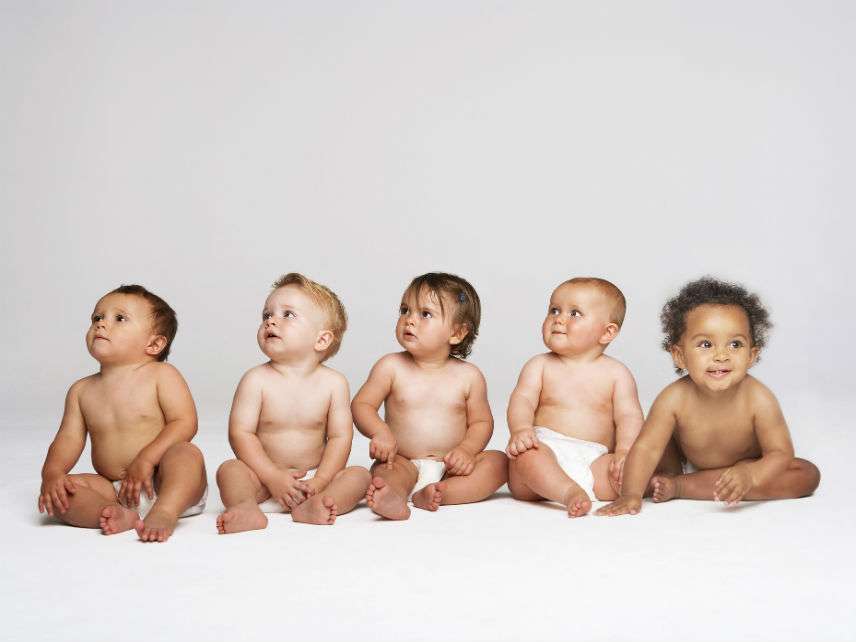Should the Government Try to Bribe You Into Having More Babies?
Increased wealth and technological progress give people greater liberty to decide when, how, with whom, and if they want to reproduce.

"Our fertility decline is on par with serious, durable fertility declines in other big, developed countries, and may be extremely difficult to reverse," warns Lyman Stone, an economist at the U.S. Department of Agriculture. By his calculations, America's total fertility rate has dropped from 2.1 kids per woman in 2007 to 1.77 now. Stone thinks this is a problem. Is it?
The total fertility rate is defined as the average number of children that would be born to a woman over her lifetime, all things being equal. The population replacement rate is conventionally defined as 2.1 children per woman: one to replace each parent, plus a few more to make up for kids who die or fail to reproduce.
Lyman acknowledges that fertility in the U.S. has fallen even more steeply in the past. For example, the total fertility rate dropped in just six years from 2.48 to 1.74 kids per woman between 1970 and 1976. It bounced back to basically the replacement rate in the 1990s and 2000s.
Lyman suggests that this time the fall will continue, dropping soon to the lowest domestic rates ever. Most other developed countries, he notes, have stayed below the replacement rate for decades. Low fertility, he fears, threatens the future of American economy and culture. He glumly notes that even extremely generous pro-natalist policies in European Union countries, Russia, and other developed nations have failed to boost fertility above replacement in those countries.
For example, France provides 26 weeks of paid maternity leave for a third child, highly subsidized day care, and monthly allowances for families with children amounting to as much as $300 per month. Such policies correlated with a fertility boost from 1.7 children per woman in the 1990s to just over 2.0 by 2015. Yet the country's total fertility then fell to 1.93 in 2016.
Stone's article provoked New York Times columnist Ross Douthat into a Twitter paroxysm. Trumpian populists, he despaired, were failing to engage in a "'natalists versus globalists' policy debate." Specifically, the pro-natalist Douthat was peeved that populist-in-chief Trump had dismissed a tax-bill amendment from Sens. Marco Rubio (R-Fla.) and Mike Lee (R-Utah). The bill already includes language doubling the child tax credit from $1,000 to $2,000 per kid; Rubio and Lee want to make the credit refundable against payroll tax liability. The idea is to enable lower-income folks who pay little or no income tax to benefit from the credit by offsetting their payroll tax payments. (Without something like the Rubio/Lee amendment, the Center for Budget Priorities calculates that about 10 million children with low-income parents would receive a token benefit of $75 or less from the Senate's increase in the child tax credit.) Rubio and Lee want to pay for their proposal by lowering the corporate income tax rate to just 22 percent, not the 20 percent preferred by the president.
The current $1,000-per-child credit phases out at incomes higher than $150,000 for married filers with two children. In the Senate version, it would phase out in the case of married couples with two children whose incomes exceed $580,000. Since high-income people pay more income tax, they would be able to take full advantage to the new child tax credit to reduce their tax bills. This could be interpreted as trying to bribe high-income folks—who have lower fertility rates—into having more kids.
In any event, it costs about $233,610 to rear a child, so $2,000 a year isn't likely to be all that persuasive. But from Douthat's point of view, every little bit helps.
I, on the other hand, can't see why the government should be trying to manage how many kids people have in the first place. Fertility is falling because people are making trade-offs between having more children and more education, more career advancement, more disposable income, and more leisure. In addition, many people are choosing to have fewer children so that they can invest more in helping the children they do have to lead successful lives. Falling fertility is a sign that increased wealth and technological progress have given increasing numbers of people greater freedom to decide if, when, how, and with whom they want to reproduce. And that's a good thing.
For more background, see my article "Why Are People Having Fewer Kids?"
Disclosure: My wife and I try not to flaunt our voluntarily child-free lifestyle too much.


Show Comments (128)